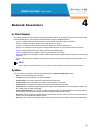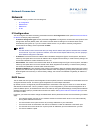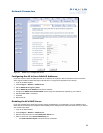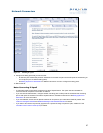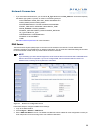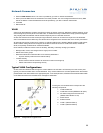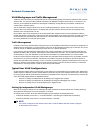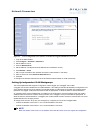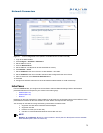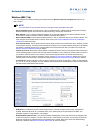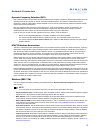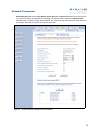
69
Network Parameters
4. Enter the DNS Domain name. This name is provided by your ISP or network administrator.
5. Enter up to three DNS Server IP addresses in the fields provided. You must configure at least the Primary DNS
Server IP address. These IP addresses should be provided by your ISP or network administrator.
6. Click OK.
7. Reboot the AP.
VLAN
Virtual Local Area Networks (VLANs) are logical groupings of network resources. Defined by software settings, VLAN
resources appear (to clients) to be in the same room, no matter where they are attached on the physical LAN segment.
They simplify traffic flow between clients and their frequently-used or restricted resources.
VLANs now extend as far as the access point signal reaches; clients can connect from anywhere in the broadcast
area. The broadcast area is defined by the network name configured for the wireless card on the access point device.
AP-2500 devices are fully VLAN-ready; however, by default VLAN support is disabled. Before enabling VLAN support,
certain network settings should be configured, and network resources such as a VLAN-aware switch, a RADIUS
server, and possibly a DHCP server should be available.
Once enabled, VLANs are used to more conveniently, efficiently, and easily manage your network.
• Manage adds, moves, and changes from a single point of contact
• Define and monitor groups
• Reduce broadcast and multicast traffic to unnecessary destinations
– Improve network performance and reduce latency
• Increase security
– Secure network restricts members to resources on their own workgroup
– Clients roam without compromising security
Typical VLAN Configurations
VLANs collect and distribute data through the cards installed in the AP-2500. An Ethernet port on the access point
typically connects a wireless cell to a wired backbone. They communicate across a VLAN-capable switch that reviews
packet headers and directs traffic to the appropriate ports. In the example below, a RADIUS server authenticates traffic
on the Ethernet network and a DHCP server manages IP addresses.
Figure 4-4 Components of a typical VLAN
In this figure, the numbered items correspond to the
following components:
1. VLAN-enabled AP
2. VLAN-aware switch (IEEE 802.1Q uplink)
3. AP-2500 management via wired host
(SNMP, Web interface or CLI)
4. DHCP Server
5. RADIUS Server
6. VLAN 1 (Wireless Card A)
7. VLAN 2 (Wireless Card B)




